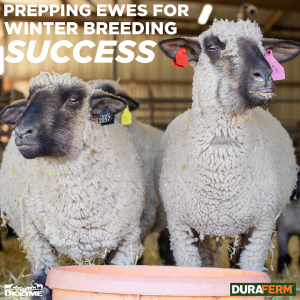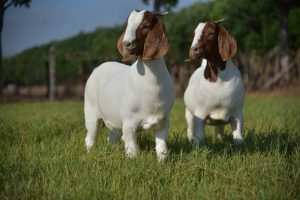
Goat Gestation
As genetics selection tools and reproduction traits advance, the ability to duplicate superior genetics has become easier through the use of advanced reproductive technologies. Although embryo transfer (E.T.) and artificial insemination (A.I.) are not quite as common in goats as they are in cattle and sheep, the technologies allow for the propagation of elite genetic packages through the use of host or recipient does.
Goat gestation is perhaps the most anticipated time of the operation, especially if you have flushed your superior donor females. You’ve selected the matings, flushed the does and implanted the embryos. Now, you wait approximately five months to see what kind of wonderful offspring is produced.
Just like the donors, the ones that are carrying the embryos, commonly referred to as recips, need and deserve the same care and attention as any other breeding female.
Preparing for Goat Gestation
Since the DuraFerm team isn’t made up of reproductive experts, we won’t go into the science behind synchronization. That’s not our area of expertise. If you are looking for expert support, it is important to work with your veterinarian or reproductive technician. They can help you ensure that the donor does and recipients are synchronized so that they are on the same reproductive schedule.
Once you do that, female health and nutrition are of the highest concern. And THAT is our area of expertise. Ensuring your does are free from any health issues or parasites can significantly improve breeding outcomes. That also leads to better overall herd health.
That’s where proper nutrition, health, wellness monitoring and quality of life come into play. If you want quality outcomes, keeping your body healthy and happy is essential to optimizing fertility and supporting a developing fetus.
But what does that care look like?
Pay Attention to Their BCS
Body Condition Score (BCS) of both your donors and recipients is important as you prepare for goat embryo transfer. BCS in goats range from 1 to 5, with 1 being way too thin and 5 being overly conditioned or obese. A good body condition score for does going into breeding season is 2.5 to 4.
BCS in goats is best assigned by both visual appraisal and handling your goats in three areas.
- First, evaluate the lumbar, which is the area of the back behind the ribs containing the loin.
- Next, you will assess the fat covering on the sternum (breastbone).
- Finally, you should feel the fat cover on the rib cage and between the ribs.
A doe, especially one with a low BCS, will have a challenging time getting and staying bred. Females that are under-conditioned and malnourished greatly inhibit reproductive success. As nutrition is partitioned, reproductive needs are the first sacrificed. The doe will first use nutrients for growth and her own energy before she uses them for reproduction. Excessive body condition also makes it challenging for the doe to cycle. This is why it is important for both the donor and the recipients to be the proper BCS
Monitor Their Nutrition
One of the most important aspects of getting your herd ready for goat gestation is providing both the donors and the recipient does with the most complete diets possible. This includes a balance of vitamins, minerals, water, protein, energy, and forages.
“The recip is the host, literally taking care of the embryo, so her plane of nutrition is just as important as the donors. Make sure all does are on Concept•Aid® mineral to make sure they get their trace minerals,” said Sam Silvers, BioZyme Director of National Specialty Livestock. “It’s important to ensure the does are not overly fat or not too thin.”
Keep Their Vaccinations Up to Date
Many producers will vaccinate their herd only before kidding season. However, if you are the type of producer who likes to work proactively, you can add a second round of vaccinations. Those should be administered just prior to breeding.
If you do choose to vaccinate, overeating disease (enterotoxemia) and tetanus are the two recommended vaccines. Vaccinate just prior to breeding for the best results. You should also deworm your doe, as worms can wreak havoc on body condition score and the ability to breed and maintain pregnancy.
Keep Their Feet Trimmed
Make sure to trim your does’ hooves. As gestation progresses, they will be carrying extra weight, and you want to ensure they have a good set of wheels under them to carry that weight. Additionally, trimming hooves prior to breeding will not disturb the pregnancies.
Group Your Animals
Goats are very social animals. Make sure they have been grouped together prior to their transfer dates, so they have already determined a pecking order. That way they are not trying to establish dominance while in gestation and growing their babies.
DuraFerm® Can Help
DuraFerm® is a line of nutritional supplements for sheep and goats that supports optimal digestion and nutrition for maximized performance at every stage of production. For goats, we offer two products designed to help strengthen your stock and support reproductive success.
DuraFerm® Goat Concept•Aid®
DuraFerm Goat Concept•Aid is a free-choice vitamin and mineral supplement for goats designed to support reproductive success. Goat Concept•Aid contains AO-Biotics® Amaferm®, a prebiotic research proven to enhance digestibility. It also includes high levels of vitamin E for reproductive tract repair and supports embryo production and conception using organic trace minerals. It comes in a 50-pound bag.
DuraFerm® Goat Concept•Aid® Protein Tub
DuraFerm Goat Concept•Aid Protein Tub is a 50-pound protein tub with vitamins and minerals for goats designed to support reproductive success. It also contains Amaferm, a prebiotic research-proven to enhance digestibility. The 20% natural protein tub contains the Concept•Aid goat mineral package and supports embryo production and conception using organic trace minerals and high levels of vitamin E.
Both products are recommended to be fed to the entire herd 30 days prior to kidding through at least 30 days post-breeding. They can be fed year-round to both does and bucks, and for increased protein at kidding, switch between the loose mineral to the tub.
More about DuraFerm for Goat Gestation
The average gestation length (length of pregnancy) of a goat is 150 days or roughly five months. DuraFerm has created a Goat Gestation Calculator to make it simple for you to calculate the gestation length of your does.
Our customers believe in the DureFerm Concept•Aid for their advanced reproductive technologies. Read some of their success stories:
In Arkansas. . .
“I was not having great results in the last couple of years with the flushes in our program, and that’s the main reason I wanted to try DuraFerm®. I put all of my recips and flush does on DuraFerm about 60 days ahead of time, and my flushes have gone from 20-40% so far this year to 60-80%, so I am tickled to death and very happy with those numbers. By far the biggest goal I had was to see if I could improve the number of embryos we get on a flush and the number of embryos to stick, and that’s where I have definitely seen some improvements in my program with DuraFerm being one of the new additions in my program this year.” – Scott Hoyle, DVM
In North Carolina. . .
“Using DuraFerm Goat Concept•Aid mineral and DuraFerm Goat Concept•Aid Protein Tubs, I had 3 does produce 59 embryos and an 87% conception rate on recips.” – Noah Henson
In North Dakota. . .
“Thanks for the mineral. We have an overall kidding success rate of 95% for the year. Last March we had 35% and this year it has increased to 85%. March is a tough delivery month after mom has depleted her vitamins and minerals over the winter. This DuraFerm really made a difference! Last March I had a mom tested for vitamin deficiency, which showed low levels of vitamins E and A. This year that same doe is raising show-worthy twins!” – Hagen Goat Ranch
The Last Word
Goat gestation is exciting and nerve-wracking all at once. Just remember: take care of your does, and your does will take care of your kids!
Furthermore, this is just one resource. We might know a thing or two about nutrition, but we are not trained animal caretakers. We encourage you to establish a relationship with your veterinarian.
Whether you’ve been raising goats for 10 years or 10 months, you will always have some issue arise that requires medical attention. Your veterinarian already having insights into your herd and your operation will make their job of caring for your animals easier. In short, having a trusted relationship with your vet is the best way to support your herd.
Get your DuraFerm Today
Do you want to get your donors and recipients into tip-top shape with DuraFerm Goat Concept•Aid products powered by AO-Biotics Amaferm? You can! DuraFerm is available through the extensive BioZyme dealer network. Locate a dealer near you today.
Don’t forget to use our Goat Gestation Calculator. This handy guide will help you with all your goat breeding calculations.
You can also learn more about DuraFerm from our educational blog series or by signing up for our newsletter

